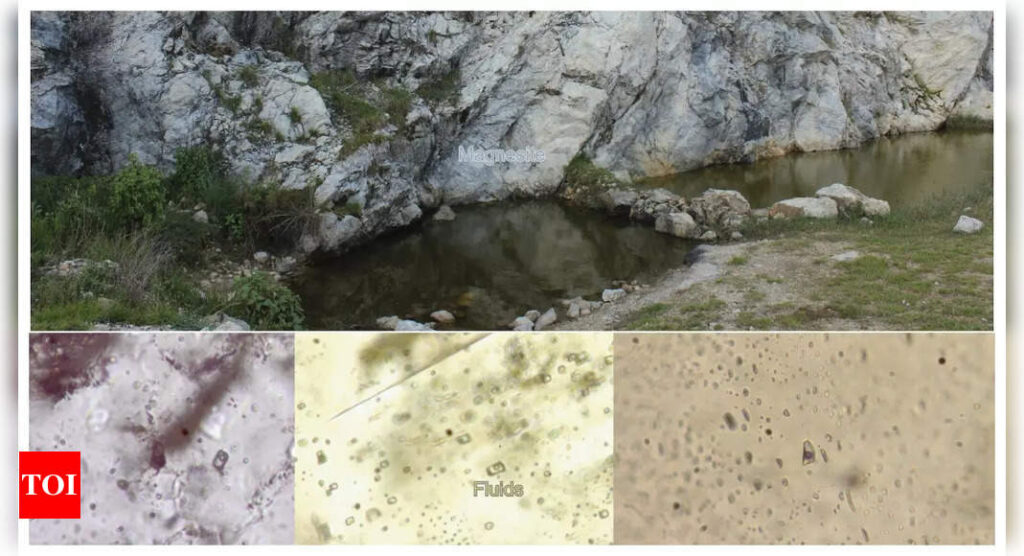[ad_1]
Researchers from the Indian Institute of Science (IISc) and Niigata University in Japan believe that these deposits can provide information about ancient oceanic conditions such as pH, chemistry and isotopic composition, which have so far only been theorised or modelled. Such information can also help answer questions related to the evolution of oceans, and even life, in Earth’s history.
Analysis of the deposits, which had both calcium and magnesium carbonates, also allowed the team to provide a possible explanation for events that might have led to a major oxygenation event in Earth’s history, an IISc statement said. Scientists believe that between 700 and 500 million years ago, thick sheets of ice covered the Earth for an extended period, called the Snowball Earth glaciation (one of the major glacial events in Earth’s history). What followed this was an increase in the amount of oxygen in the Earth’s atmosphere, called the Second Great Oxygenation Event, which eventually led to the evolution of complex life forms.
Sajeev Krishnan, professor at Centre for Earth Sciences (CEaS), IISc, and corresponding author of the study, told
TOI
that “the joint research team from IISc and Niigata University have been working on a study on the tectonic evolution of Himalayan and Nagaland belt for the last five years. During their study, the team made this discovery and gained knowledge about the formation of these rocks. He said there were three researchers from IISc, including him and his students, and a student and professor from Japan. Sajeev said the latest discovery “will open up a major opportunity to work on these rocks and included fluid. In a broader sense, our research will provide a clue on the Earth’s tectonic history”.
So far, scientists have not fully understood how these events were connected due to the lack of well-preserved fossils and the disappearance of all past oceans that existed in the Earth’s history. Exposures of such marine rocks in the Himalayas can provide some answers.
“We have found a time capsule for paleo oceans,” said Prakash Chandra Arya, PhD student at the CEaS, IISc, and first author of the study published in Precambrian Research. “We don’t know much about past oceans,” Prakash said. “How different or similar were they compared to present-day oceans? Were they more acidic or basic, nutrient-rich or deficient, warm or cold, and what was their chemical and isotopic composition?” Such insights could also provide clues about the Earth’s past climate, and this information can be useful for climate modelling, he added.
The calcium deprivation also likely led to a nutrient deficiency, making it conducive for slow-growing photosynthetic cyanobacteria, which could have started spewing out more oxygen into the atmosphere. “Whenever there is an increase in the oxygen level in the atmosphere, you will have biological radiation (evolution),” Prakash said.
The team hunted for these deposits across a long stretch of the western Kumaon Himalayas, extending from Amritpur to the Milam glacier, and Dehradun to the Gangotri glacier region. Using extensive laboratory analysis, they were able to confirm that the deposits are a product of precipitation from ancient ocean water, and not from other places, such as the Earth’s interior (volcanic activity).
The deposits found by the team – which date back to around the time of the Snowball Earth glaciation – showed that the sedimentary basins were deprived of calcium for an extended period, probably due to low riverine input. “During this time, there was no flow in the oceans, and hence no calcium input. When there is no flow or calcium input, as more calcium precipitates, the amount of magnesium goes up,” explains Sajeev Krishnan, Professor at CEaS and corresponding author of the study. The magnesium deposits formed at this time were able to trap paleo ocean water in their pore space as they crystallised, the researchers suggest.
[ad_2]
Source link











More Stories
Congress replaces Kamal Nath, names an OBC as Madhya Pradesh chief | India News
Fire breaks out in ITBP camp in Srinagar; none hurt | India News
Parliament Security: Co-villagers give clean chit to Lalit Jha, parents to move court | India News